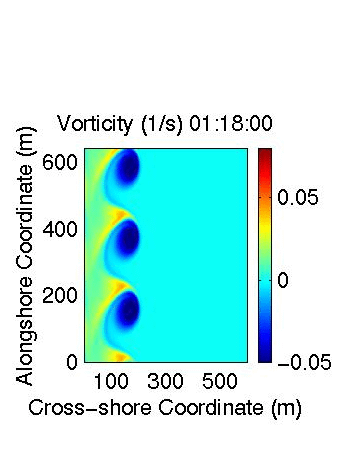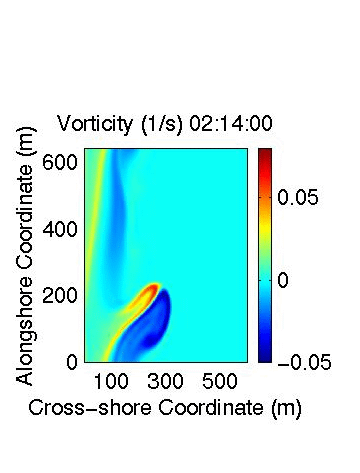

kepsilon - 1-D k-epsilon Ocean Turbulence Model
kepsilon is a 1-D tubulence model that integrates
mean-flow, and turbulence equations as a function of the vertical.
The turbulence model is in base configuration a k-epsilon model.
The model includes stratification, waves, breaking waves tke sources,
and in the near future bubbles and sediment.
The code is still under development, however it may be of interest
to others. The latest version is kepsilon-0.6.0 and is the source code is available
as a tarred and gzipped file
kepsilon-0.6.0.tar.gz.
The code is licensed under the GNU GPL This is the first version publicly released.
1-D Alongshore Current and Setup Model
This model solves the 1-D alongshore momentum equation
which balances wave-forcing against bottom stress and lateral mixing of
momentum (e.g. Longuet-Higgins, 1970; Thornton & Guza, 1986;
Church & Thornton, 1993) and is implemented in matlab. The
wave-forcing is given by the wave-transformation model in Church &
Thornton (1993). The wave transformation model is a separate
module and can be used independently to calculate wave height distributions.
The modularity also allows different wave models (ie. roller models) to
be used. The lateral mixing is either ignored, or is given by an
eddy viscocity formulation where the eddy viscocity is given by Battjes
(1975). There are a number of choices for the
parameterization of the bottom stress. These include the linearized
weak-current parameterizations and more complicated nonlinear formulations
(Feddersen et al., 1999).
Click on falk-matlabV.tar.gz to download the matlab code.
Time-dependent Nearshore Circulation Model
This model is based on the forced and dissipative rigid-lid shallow water equations. It can be used to study the dynamics of shear waves in the nearshore, and is similar to the model of Allen et al. (1996). Indeed it has been tested by reproducing features seen in both Allen et al. (1996) and Slinn et al. (1998). Periodic boundary conditions are used in the alongshore. Currently, the model is limited to cases where the bathymetry varies only in the cross-shore direction. A version that works with arbitrary bathymetry is being developed.
The model can produce vorticity maps (units 1/s), as shown below.
The model is run with a planar bathymetry, and an alongshore domain three
tiems the most unstable wavelength given from linear stability analysis.
The model run was with a small friction coefficient (high Reynolds number), to make the flow
is highly unstable. Three aspects of the shear wave evolution are shown below:
the initial growth of the instability, the transformation to longer wavelengths, and
the offshore ejection of vorticity.

|
This vorticity plot is during the initial growth of the shear waves and corresponds to predictions from linear stability (i.e. Bowen and Holman, 1989). Click here to see an animation (700Kb) of this process. The shear waves become visibile 1:08:00 into the model run. At about 1:20 (after 12 minutes), the shear waves stop growing and begin to equilibrate through the next ten minutes. |

|
Here, the shear waves are undergoing a transition to longer wavelengths. This process is described in Allen et al. (1996). Click here to see an animation (700Kb) of this process. Three equilibrated shear waves appear to undergo a second instability. First, two shear waves merge (starting round 1:50:00) leaving just two shear waves (around 1:55:00) with different magnitudes. The stronger shear waves appears to move faster and catches up with the slower wave around 2:00:00 forming a single wave, or front at the end of the animation. |

|
After the transition to longer wavelengths, vorticity begins to be intermitently shed from the surf zone offshore. This process is also described by Allen et al. (1996) and Slinn et al. (1998). Shown is the first ejection event which occurs shortly after the transition from three shear waves to a single shear wave. Click here to see an animation (700 Kb) of this process. As the vorticity gets ejected offshore and the water gets deeper, the magnitude of the vorticity increases to conserve potential vorticity. Eventually this eddy dissipates due to bottom friction and also due to biharmonic friction. |
For more information on these models and rough documentation
contact me at falk@coast.ucsd.edu
.
References
Allen, J. S., P. A. Newberger, and R. A. Holman, J. Fluid Mech., 310, 181-203, 1996.
Bowen, A. J. and R. A. Holman, J. Geophys. Res., 94, 18,023-18,030, 1989.
Battjes, J. A., Proc of Symp on Modeling Techniques, ASCE, 1050-1061, 1975.
Church, J. C. and E. B. Thornton, Coastal Eng., 20, 1-28, 1993.
Feddersen, F., R. T. Guza, S. Elgar, T. H. C. Herbers, J. Geophys. Res., 105, 8673--8686, 2000.
Longuet-Higgins, M. S., J. Geophys. Res., 75, 6790-6801, 1970.
Slinn, D. N., J. S. Allen, P. A. Newberger, and R. A. Holman, J. Geophys. Res., 103, 18,357-18,379, 1998.
Thornton, E. B. and R. T. Guza, J. Phys. Oceanogr., 16, 1165-1178, 1986.